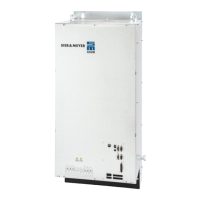18.2 Power Consumption of a Drive
If a constant torque is taken from the drive, the power consumption will depend on the
current speed.
Examples:
▸
Preset torque: 30 Nm
▸
DC link voltage: 300 V
▸
Voltage constant: 50 mV / min (50 V / 1000 rpm)
▸
Coil resistance: 1 Ω
▸
Torque constant: 1 Nm / A
From this results a motor current of:
The motor requires a voltage of V = 1 Ω × 30 A = 30 V
0 rpm, standstill
From this results a power of P = 30 V × 30 A = 0.9 kW.
At a DC link voltage of 300 V an input current results from the supply voltage of
I = P / 300 V = 3 A.
Thus, considerably less current flows in the power supply unit than in the motor. This cal-
culation is very important especially for nut setting applications, since the high torques
and thus currents are only required for low speeds.
2000 rpm
At 2000 rpm the motor requires a voltage of V = R × I + e.m.f. × n =
1 Ω × 30 A + 50 V / (1000 rpm) × (2000 rpm) = 130 V.
From this results a power of P = 130 V × 30 A = 3.9 kW.
At a DC link voltage of 300 V an input current results from the supply voltage of
I = P / 300 V = 13 A.
Thus, a considerable higher current flows in the power supply at a speed of 2000 rpm
than at standstill.
5400 rpm
At 5400 rpm the motor requires a voltage of V = R × I + e.m.f. × n = 1 Ω × 30 A + 50 V /
(1000 rpm) × (5400 rpm) = 300 V.
From this results a power of P = 300 V × 30 A = 9 kW.
At a DC link voltage of 300 V an input current results from the supply voltage of
I = P / 300 V = 30 A.
Thus, the same current flows in the power supply unit and in the motor at a speed of
5400 rpm. It must be considered that the currents flowing in the motor phases are lower
by factor √3 than the currents calculated above.
The examples clearly show that the expected motion profile must be considered when
dimensioning the power supply unit. An exact dimensioning can only be achieved by in-
tegrating the motion profile.
The same applies for conceiving the output stage and the motor.
175Drive System SD2 - Hardware Description
Electric Performance Dimensioning

